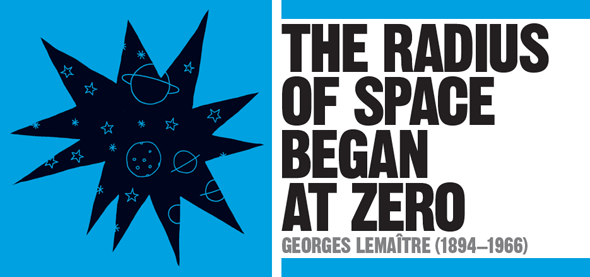
IN CONTEXT
Astronomy
1912 US astronomer Vesto Slipher discovers the high redshifts of spiral nebulae, suggesting they are moving away from Earth at high speeds.
1923 Edwin Hubble confirms that the spiral nebulae are distant, independent galaxies.
1980 US physicist Alan Guth proposes a brief period of dramatic inflation in the early Universe to produce the conditions we see today.
1992 The COBE (Cosmic Background Explorer) satellite detects tiny ripples in the cosmic microwave background radiation (CMBR) – hints of the first structure that emerged in the early Universe.
The idea that the Universe began with a Big Bang, expanding from a tiny, superdense, and extremely hot point in space, is the basis of modern cosmology, and one that is often said to have originated with Edwin Hubble’s 1929 discovery of cosmic expansion. But the precursors of the theory predate Hubble’s breakthrough by several years, and first sprang from interpretations of Albert Einstein’s theory of general relativity as it applied to the Universe as a whole.
When formulating his theory, Einstein drew on the available evidence of the time to assume that the Universe was static – neither expanding nor contracting. General relativity indicated that the Universe should collapse under its own gravity, so Einstein fudged his own equations by adding a term known as the cosmological constant. Einstein’s constant mathematically counteracted the gravitational contraction to produce the presumed static Universe.
Famously, Einstein later called the constant his greatest mistake, but even at the time he proposed it there were some who found it unsatisfactory. The Dutch physicist Willem de Sitter and Russian mathematician Alexander Friedmann independently suggested a solution to general relativity in which the Universe was expanding, and, in 1927, Belgian astronomer and priest Georges Lemaître reached the same conclusion, two years ahead of Hubble’s observational proof.
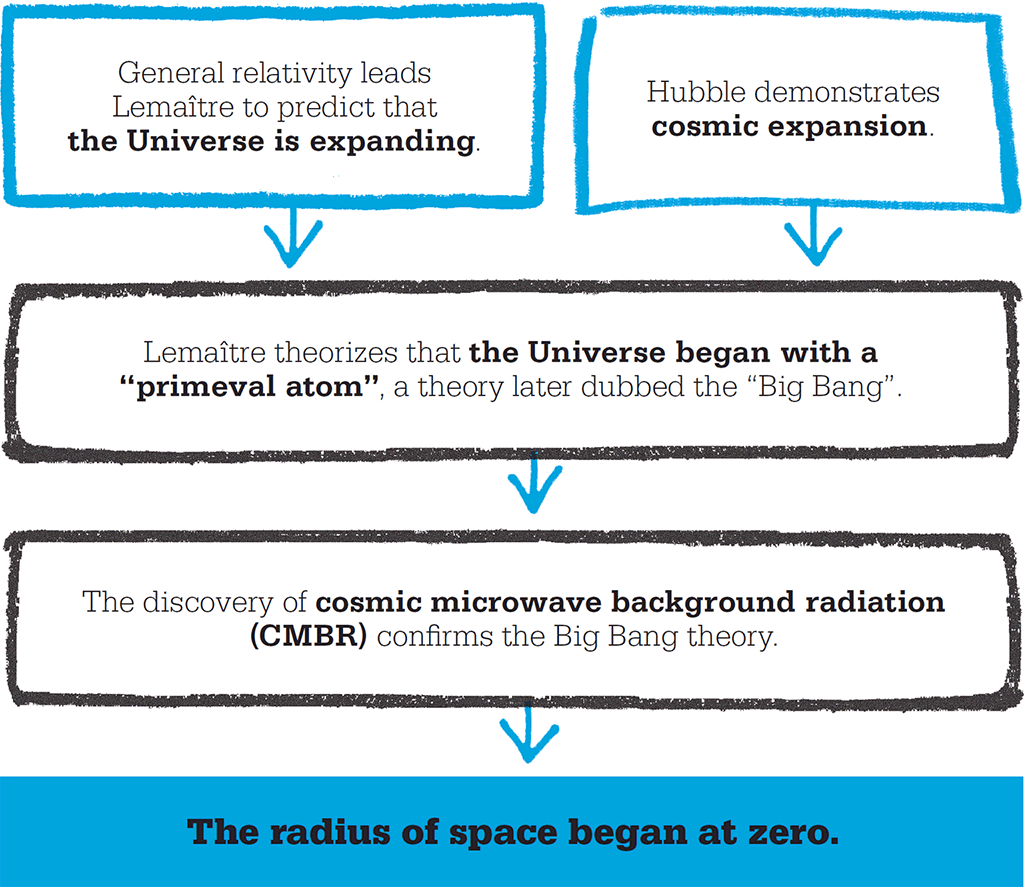
"The first stages of the expansion consisted of a rapid expansion determined by the mass of the initial atom, almost equal to the present mass of the universe."
Georges Lemaître
Beginning in fire
In an address to the British Association in 1931, Lemaître took the idea of cosmic expansion to its logical conclusion, suggesting that the Universe had sprung from a single point that he called the “primeval atom”. The response to this radical idea was mixed.
The astronomical establishment of the time was attached to the idea of an eternal Universe without end or beginning, and the prospect of a distinct point of origin (especially when proposed by a Catholic priest) was seen as introducing an unnecessary religious element into cosmology.
However, Hubble’s observations were undeniable, and some kind of model was needed to explain the expanding Universe. Numerous theories were put forward in the 1930s, but by the late 1940s, just two remained in play – Lemaître’s primeval atom, and the rival “steady state” model, in which matter was continuously created as the Universe expanded. British astronomer Fred Hoyle was the champion of the steady state idea. In 1949, Hoyle scornfully referred to the rival theory as a “Big Bang”. The name stuck.
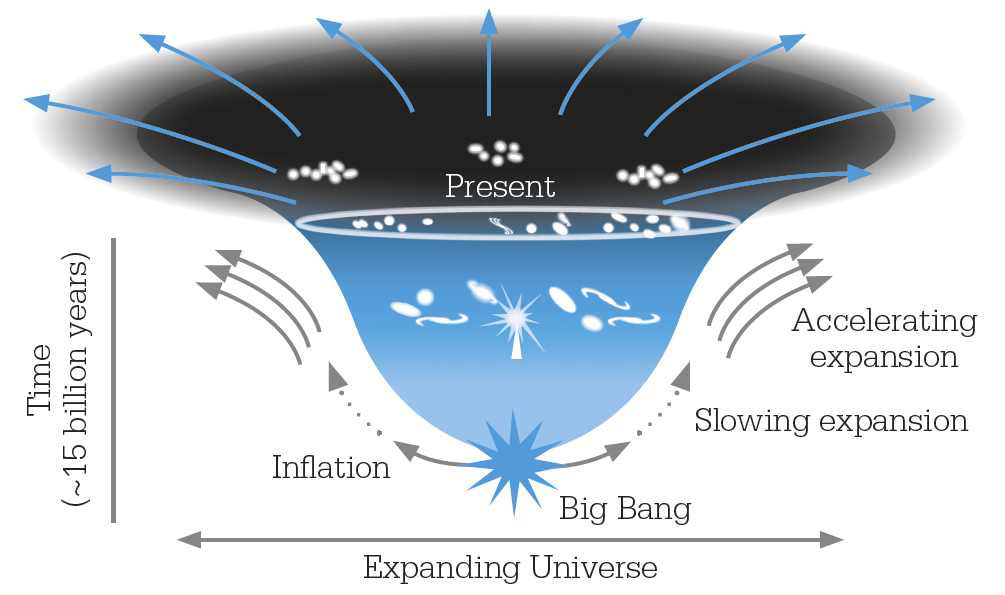
Since the Big Bang 13.8 billion years ago, the expansion of the Universe has been through different phases. There was an initial period of rapid expansion known as inflation. After that, expansion slowed, then started to speed up once more.
Making the elements
By the time Hoyle had inadvertently named the theory, a persuasive piece of evidence in favour of Lemaître’s hypothesis had been published, tipping the balance away from a steady state Universe. This was a 1948 paper written by Ralph Alpher and George Gamow of the Johns Hopkins University in the USA. It was called The Origin of Chemical Elements, and described in detail how subatomic particles and lightweight chemical elements could have been produced from the raw energy of the Big Bang, in accordance with Einstein’s equation E= mc2. But this theory, later known as Big Bang nucleosynthesis, explained a process that could form only the four lightest elements – hydrogen, helium, lithium, and beryllium. Only later was it discovered that the heavier elements of the Universe are the product of stellar nucleosynthesis (a process that takes place inside stars). Ironically, the evidence showing how stellar nucleosynthesis worked was to be developed by Fred Hoyle.
Nevertheless, there was still no direct observational evidence to determine the truth of either the Big Bang or a steady state Universe. Early attempts to test the theories were made in the 1950s using a basic radio telescope known as the Cambridge Interferometer. These tests relied on a simple principle: if the steady state theory was true, then the Universe must be essentially uniform in both time and space; but if it originated 10–20 billion years ago, as the Big Bang theory suggested, and evolved throughout its history, then distant reaches of the Universe, whose radiation had taken billions of years to reach Earth, should appear substantially different. (This cosmic time machine effect, whereby we see more distant celestial objects as they were in the distant past, is known as “lookback time”.) By measuring the number of distant galaxies emitting radiation above a certain brightness, it should be possible to distinguish between the two scenarios.
The first of the Cambridge experiments delivered a result that seemed to support the Big Bang. However, problems were discovered with the radio detectors, so the results had to be disregarded. Later results proved more equivocal.
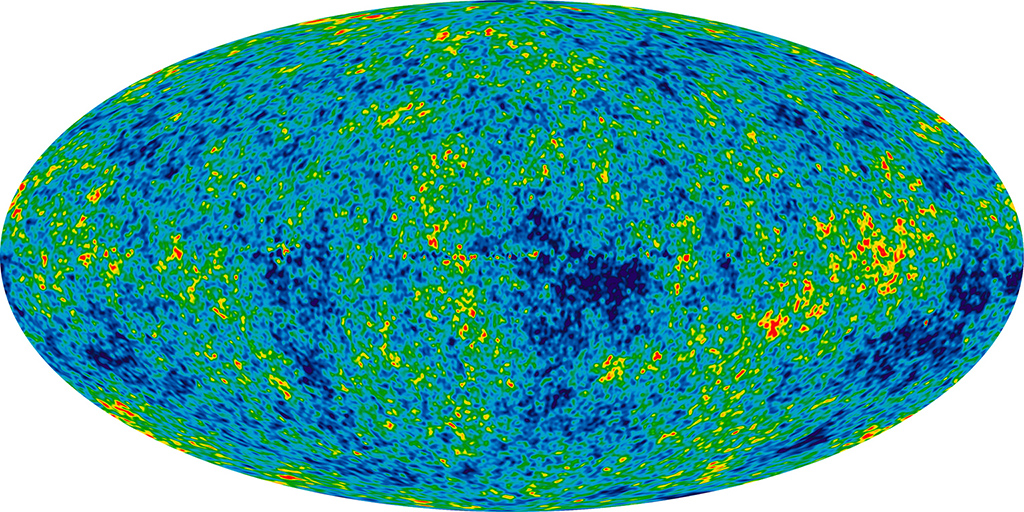
Tiny variations have been found in the cosmic microwave background radiation – the different colours in this image show temperature differences of less than 400 millionths of a Kelvin.
Traces of the Big Bang
Fortunately, the question soon resolved itself by other means. As early as 1948, Alpher and his colleague Robert Herman had predicted that the Big Bang would have left a residual heating effect throughout the Universe. According to the theory, when the Universe was about 380,000 years old, it had cooled enough to become transparent, allowing light photons to travel freely through space for the first time. The photons that existed at this time had been propagating through space ever since, growing longer and redder as space expanded. In 1964, Robert Dicke and his colleagues at Princeton University set out to build a radio telescope that could detect this faint signal, which they thought would take the form of low-energy radio waves. However, they were ultimately beaten to the prize by Arno Penzias and Robert Wilson, two engineers working at the nearby Bell Telephone Laboratories. Penzias and Wilson had built a radio telescope for satellite communication, but found themselves plagued by an unwanted background signal that they could not eliminate. Coming from all over the sky, it corresponded to microwave emission from a body at a temperature of 3.5K – just 3.5°C (6°F) above absolute zero. When Bell Labs contacted Dicke to ask for help with their problem, Dicke realized that they had found the remnants of the Big Bang – now known as the cosmic microwave background radiation (CMBR).
The discovery that the CMBR permeates the Universe – a phenomenon for which the steady state theory had no explanation – clinched the case in favour of the Big Bang. Subsequent measurements have shown that the CMBR’s true average temperature is about 2.73K, and high-precision satellite measurements have revealed minute variations in the signal that allow us to study conditions in the Universe back to 380,000 years after the Big Bang.
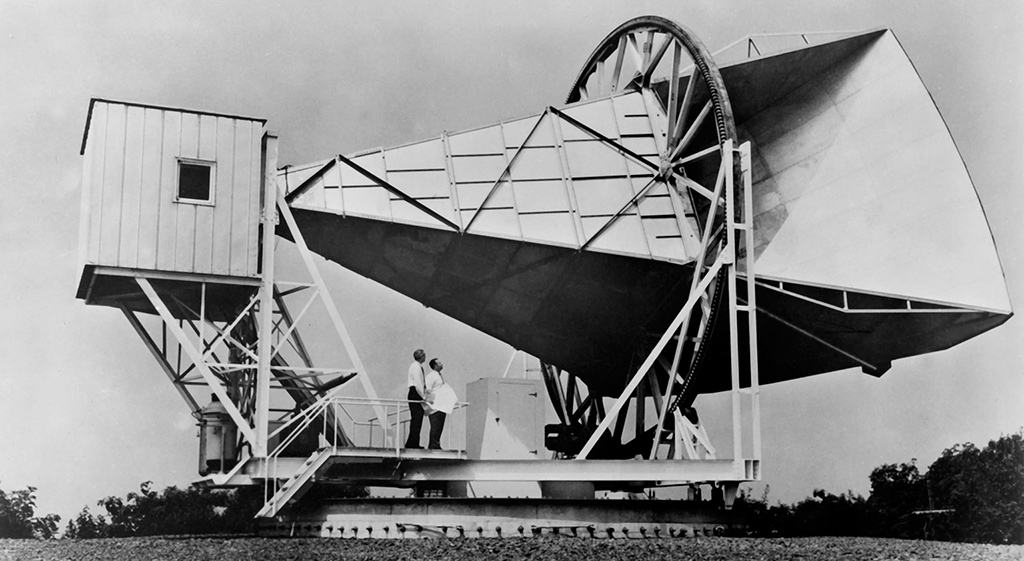
Arno Penzias and Robert Wilson detected the background radiation by accident. At first, they thought the interference had been caused by bird droppings on their radio antenna.
Later developments
Despite being proved correct in principle, the Big Bang theory has undergone many transformations since the 1960s to match it to our growing understanding of the Universe. Among the most significant are the introduction of dark matter and dark energy to the story, and the addition of a violent growth spurt in the instant after creation, known as Inflation. The events that triggered the Big Bang remain beyond our reach but measurements of the rate of cosmic expansion, aided by instruments such as the Hubble Space Telescope, now allow us to pin down the epoch of cosmic creation with great accuracy – the Universe came into existence 13.798 billion years ago, give or take 0.037 billion years. Various theories exist about the future of the Universe, but many think that it is set to continue expanding until it reaches a state of thermodynamic equilibrium, or “heat death”, in which matter has disintegrated into cold subatomic particles, in around 10100 years’ time.
GEORGES LEMAÎTRE

Born in Charleroi, Belgium, in 1894, Lemaître studied civil engineering at the Catholic University of Louvain and served in World War I before returning to academia, where he studied physics and mathematics as well as theology. From 1923, he studied astronomy in Britain and the United States. On his return to Louvain in 1925 as a lecturer, Lemaître began to develop his theory of an expanding Universe as an explanation for the redshifts of the extragalactic nebulae.
First published in 1927, in a little-read Belgian journal, Lemaître’s ideas took off after he published an English translation with Arthur Eddington. He lived until 1966 – long enough to see proof that his ideas were correct with the discovery of the cosmic microwave background radiation (CMBR).
Key works
1927 A Homogeneous Universe of Constant Mass and Growing Radius Accounting for the Radial Velocity of Extragalactic Nebulae
1931 The Evolution of the Universe: Discussion
See also: Isaac Newton • Albert Einstein • Edwin Hubble • Fred Hoyle